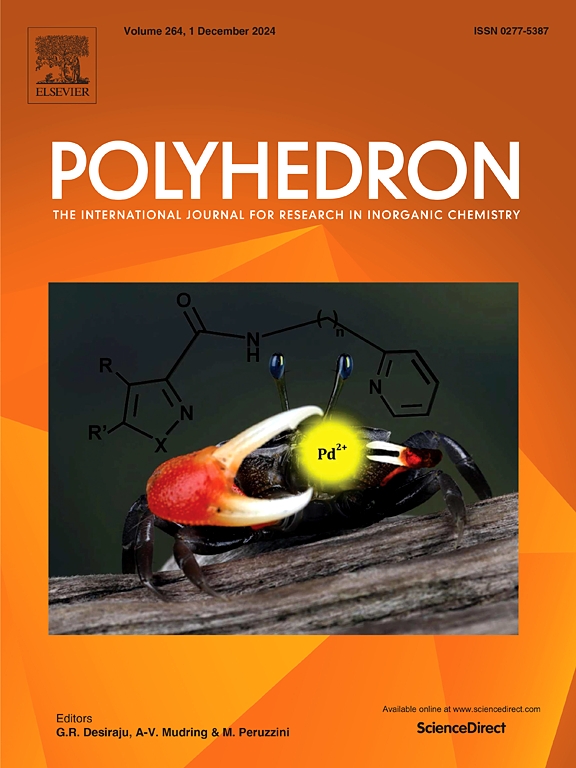Z-scheme design of hydrothermally synthesized Sm-Fe-doped LaNiO3/g-C3N4 heterostructure photo-catalyst for the efficient elimination of methylene blue & moxifloxacin pollutants
IF 2.4
3区 化学
Q2 CHEMISTRY, INORGANIC & NUCLEAR
引用次数: 0
Abstract
In this current investigation, it deals with the synthesis of a highly effective Z-scheme visible light-driven Sm-Fe-doped LaNiO3/g-C3N4 hetero-structure photocatalyst for the efficient elimination of toxic environmental pollutants from wastewater. Pristine LaNiO3 nanoparticles (NP), samarium, and iron (Sm-Fe) doped LaNiO3 NP and their nanohybrid composite Sm-Fe doped LaNiO3/g-C3N4 with 15 % (g-C3N4) graphitic-carbon-nitride was prepared via facile glycerine-assisted hydrothermal and ultra-sonication approaches. The materials for their physico-chemical properties were characterized using SEM, TEM, P-XRD, FTIR, XPS, BET, I-V, VSM, PL, and UV–visible analysis. The morphological analysis revealed that the g-C3N4 sheets interact and buffer with Sm-Fe-doped LaNiO3 NP, forming larger, elongated aggregations having highly exposed surfaces, wider particle size distributions and possessing an average particle sizes 22–34 nm. Structural investigation demonstrated the single-phase rhombohedral LaNiO3 perovskite along with successful Sm and Fe cation doping. The Sm-Fe-doped LaNiO3/g-C3N4 nanohybrid materials exhibited excellent BET surface area (96.7 m2/g), a well-porous nature with average pore sizes in the 1.5–2.6 nm range, good saturation magnetization (2.204 10−3 Ms/emu), boosted electrical conductivity (1.09 102 Sm−1) and a narrow band gap (2.06 eV), which was credited to the Sm-Fe-doping and the combination of highly conducting g-C3N4 material. It was demonstrated that Sm-Fe-doped LaNiO3 NP were uniformly dispersed on g-C3N4 nanohybrids, forming an intimate interface with robust interaction between LaNiO3 and the g-C3N4, which promoted efficient charge mobility and separation, forming a Z-scheme photocatalytic system. The photo-degradation investigation of the newly synthesized photo-catalyst was tested against methylene blue (MB) dye and moxifloxacin (MOX) drug under solar-light irradiation. The Sm-Fe-doped LaNiO3/g-C3N4 nanohybrid photocatalyst exhibited excellent removal of MB dye (97.8 %) and MOX (96.4 %) in only 55 min. This superb removal proficiency of MB dye and MOX by Sm-Fe-doped LaNiO3/g-C3N4 nanohybrid was attributed to its improved magnetic, good electrical, well-porosity, and excellent optical absorption characteristics, which make the Sm-Fe-doped LaNiO3/g-C3N4 nanohybrid as a novel materials for removing toxic environmental pollutants.

水热合成的sm - fe掺杂LaNiO3/g-C3N4异质结构光催化剂的z方案设计,用于高效消除亚甲基蓝和莫西沙星污染物
在本研究中,研究了一种高效的Z-scheme可见光驱动sm - fe掺杂LaNiO3/g-C3N4异质结构光催化剂的合成,用于有效消除废水中的有毒环境污染物。采用简单的甘油辅助水热和超声波方法制备了纯净的LaNiO3纳米粒子(NP)、钐和铁(Sm-Fe)掺杂的LaNiO3 NP及其15% (g-C3N4)石墨-氮化碳掺杂的Sm-Fe掺杂LaNiO3/g-C3N4纳米复合材料。采用SEM、TEM、P-XRD、FTIR、XPS、BET、I-V、VSM、PL和uv -可见分析对材料的理化性质进行了表征。形态学分析表明,g-C3N4薄片与sm - fe掺杂的LaNiO3 NP相互作用和缓冲,形成更大、细长的团聚体,表面高度暴露,粒径分布更宽,平均粒径为22 ~ 34 nm。结构分析表明,LaNiO3钙钛矿单相菱面体掺杂成功。Sm- fe掺杂的LaNiO3/g- c3n4纳米杂化材料具有优异的BET比表面积(96.7 m2/g)、良好的多孔性(平均孔径在1.5 ~ 2.6 nm范围内)、良好的饱和磁化强度(2.204 × 10−3 Ms/emu)、提高的电导率(1.09 × 102 Sm−1)和窄带隙(2.06 eV),这主要归因于Sm- fe掺杂和高导电性g- c3n4材料的结合。结果表明,sm - fe掺杂的LaNiO3 NP均匀地分散在g-C3N4纳米杂化体上,LaNiO3与g-C3N4之间形成了一个紧密的界面,具有强大的相互作用,促进了有效的电荷迁移和分离,形成了Z-scheme光催化体系。在日光照射下,对新合成的光催化剂对亚甲基蓝(MB)染料和莫西沙星(MOX)药物进行了光降解研究。sm - fe掺杂的LaNiO3/g-C3N4纳米杂化光催化剂在55 min内对MB染料(97.8%)和MOX(96.4%)表现出优异的去除率。sm - fe掺杂的LaNiO3/g-C3N4纳米杂化光催化剂对MB染料和MOX的去除率优异,归功于其改善的磁性、良好的电学特性、良好的孔隙率和优异的光学吸收特性,这使得sm - fe掺杂的LaNiO3/g-C3N4纳米杂化光催化剂成为一种去除有毒环境污染物的新型材料。
本文章由计算机程序翻译,如有差异,请以英文原文为准。
求助全文
约1分钟内获得全文
求助全文
来源期刊

Polyhedron
化学-晶体学
CiteScore
4.90
自引率
7.70%
发文量
515
审稿时长
2 months
期刊介绍:
Polyhedron publishes original, fundamental, experimental and theoretical work of the highest quality in all the major areas of inorganic chemistry. This includes synthetic chemistry, coordination chemistry, organometallic chemistry, bioinorganic chemistry, and solid-state and materials chemistry.
Papers should be significant pieces of work, and all new compounds must be appropriately characterized. The inclusion of single-crystal X-ray structural data is strongly encouraged, but papers reporting only the X-ray structure determination of a single compound will usually not be considered. Papers on solid-state or materials chemistry will be expected to have a significant molecular chemistry component (such as the synthesis and characterization of the molecular precursors and/or a systematic study of the use of different precursors or reaction conditions) or demonstrate a cutting-edge application (for example inorganic materials for energy applications). Papers dealing only with stability constants are not considered.
 求助内容:
求助内容: 应助结果提醒方式:
应助结果提醒方式:


